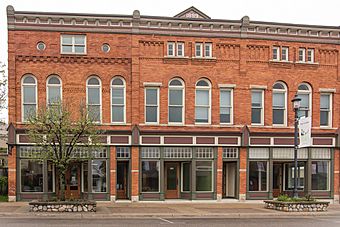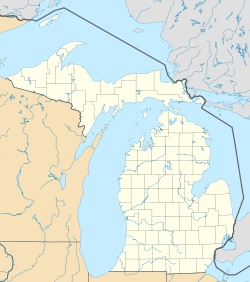East Jordan Lumber Company Store Building facts for kids
Quick facts for kids |
|
|
East Jordan Lumber Company Store Building
|
|

East Jordan Lumber Company (right) next to the Votruba Block (left)
|
|
| Location | 104 Main St, East Jordan, Michigan |
|---|---|
| Area | less than one acre |
| Built | 1899 |
| Architectural style | Late Victorian |
| NRHP reference No. | 08000586 |
| Added to NRHP | July 3, 2008 |
The East Jordan Lumber Company Store Building is a historic building located at 104 Main Street in East Jordan, Michigan. It was added to the National Register of Historic Places in 2008. This means it's an important place recognized for its history. The building shares a wall with the Votruba Block. Both buildings have been updated and now form the Main Street Center office complex.
Contents
What is the History of the East Jordan Lumber Company Store?
East Jordan was first settled in the late 1870s. In 1879, a man named Joseph Glenn moved a sawmill to the area. Around the same time, he built a small, one-story wooden general store. This store sold many different things. You could buy groceries, tools, kitchen items, and clothes there.
Soon after, Joseph Glenn's nephew, William P. Porter, bought half of the business. The store was then called Glenn & Porter. In 1888, Glenn sold his share of the mill. The company then changed its name to the East Jordan Lumber Company.
When Was the Current Building Constructed?
Around 1899, the original wooden store was moved to another street. Construction began on the building you see today. It was likely built at the same time as the next-door Votruba Block. The new building housed the East Jordan Lumber Company's general store. This store took up both first-floor sections. The company offices were on the second floor. William P. Porter and later his sons had offices there. Other parts of the second floor were used by a Masonic Lodge. Doctors and dentists also had offices in the building.
What Happened to the Store Over Time?
The East Jordan Lumber Company mills closed in the 1920s. However, William P. Porter had already started the East Jordan Canning Company. This company used and promoted farm crops from the area. The general store stopped selling clothes and dry goods in the 1920s. It focused on hardware and groceries instead.
The store continued until 1938. At that time, the grocery part was sold to Mr. and Mrs. E.H. Clark. They had been running the store since the late 1920s. In 1939, the hardware part of the store was sold to William A. Porter. He was one of William P. Porter's sons.
The grocery store operated until the 1950s. It was known as Quality Food Market and later Maxwell Market. After that, a five-and-dime store took its place. The hardware store continued into the 1950s as Porter Hardware, then Olson Hardware. Professional offices stayed on the second floor into the 1960s. In the 1970s, Snizbee's Five and Dime occupied the building. By the 1990s, the building was empty.
When Was the Building Restored?
From 2002 to 2004, the building was restored. This was part of the Main Street Center office building project.
What Does the East Jordan Lumber Company Store Building Look Like?
The East Jordan Lumber Company Store Building is a two-story brick building. It is built in a style called Late Victorian. The building is about 46 feet wide and 100 feet deep. It is made of red brick with wood framing and an iron cornice (a decorative top edge).
What Are the Building's Features?
The front of the building has two storefronts. Each storefront has an entrance on the ground floor. A staircase to the second story is located between the storefronts. The second story has four double-hung windows above each storefront. The two middle windows have round arches at the top.
The attic level has pairs of small double-hung windows above the round-arched ones. These are surrounded by vertical brickwork. Decorative brickwork and a pressed metal cornice top the building. The street-level storefront has been rebuilt to match the Victorian style of the building.
How Has the Inside Changed?
The first floor originally had a large open space. The second floor had a long hallway with offices on both sides. During the restoration, both floors were changed into office suites.


